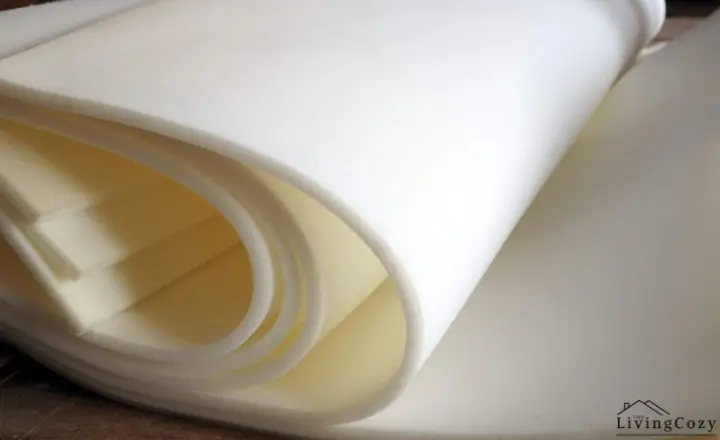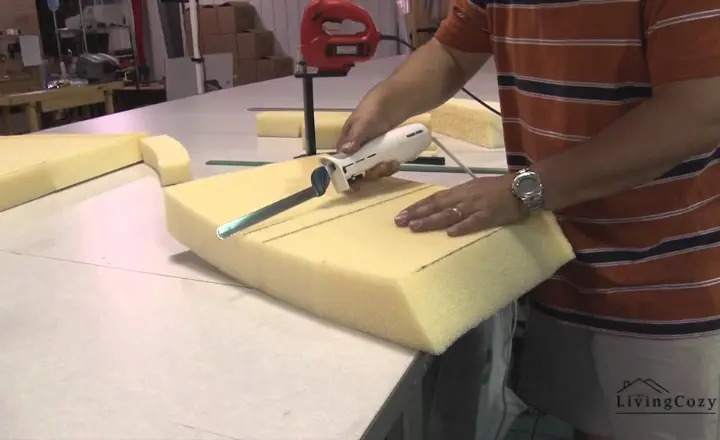Replacing couch cushion foam is a relatively simple process that can breathe new life into your old sofa.
Perhaps you’ve noticed sagging or lumpy cushions that don’t provide the same comfort they used to. We’ll explore instructions on how to replace couch cushion foam, saving you from spending a small fortune on a new piece of furniture and giving your old faithful couch a new lease on life.
So, let’s dive into the article.
What Is Couch Cushion Foam?
Couch cushion foam is the material used to provide support and comfort in the cushions of a couch. It is typically made from polyurethane foam, which has different densities and firmness levels. The foam is often wrapped in batting or fabric to provide additional softness and protection.
The quality and type of foam used in couch cushions can greatly impact the comfort and longevity of the furniture. Higher-density foams tend to be more durable and supportive, while lower-density foams may feel softer but can compress more quickly over time.
Couch Cushion Foam Density:

Regarding couch cushion foam density, it’s important to consider the pounds per 12 x 12 x 12 block measurement. Higher-density foam means more foam in the same space, offering greater comfort and durability over time.
While high-density cushions may feel firm initially, they soften over time and provide long-lasting support. Low-density cushions tend to flatten quickly, so it’s best to opt for a density of 2 to 2.5 for optimal comfort and longevity. The industry standard is 1.8, considered low density, and the density scale ranges from 0 to 5.
When choosing replacement couch cushion foam, aim for a higher density (2 to 2.5) for long-lasting comfort and durability. Higher-density foam provides better support and resilience than lower-density options, which tend to flatten quickly and lack longevity.
Remember that the industry standard is 1.8, so opting for a higher density within the 2-2.5 range can ensure a more comfortable and durable seating experience.
How to Replace Couch Cushion Foam?
To replace couch cushion foam:
- Measure the dimensions of your couch cushions to determine the size of foam needed.
- Purchase high-density foam that matches the measurements of your cushions.
- Remove the old foam from the cushion covers by unzipping or cutting them open.
- Place the new foam into the cushion covers, ensuring a snug fit.
- Use spray adhesive to secure the foam in place if necessary.
- Zip or sew the cushion covers closed once the new foam is inserted.
- Fluff and reshape the cushions to ensure they are even and comfortable.
- Enjoy your newly refreshed couch cushions.
What Type of Foam is Best For Your Couch Cushions?
The best type of foam for your couch cushions depends on your preferences and budget. High-density foam, such as polyurethane foam, is popular for its durability and support. It can provide firmness and resilience for long-lasting comfort.
Memory foam offers a more plush and contouring feel, making it a good option for those seeking extra cushioning and pressure relief.
It may be pricier than traditional high-density foam. The best type of foam for your couch cushions will depend on your specific comfort needs and budget constraints.
How to Cut Couch Cushion Foam?

You will need a sharp utility knife or an electric carving knife to cut couch cushion foam. Measure and mark the dimensions of the foam you want to cut using a ruler and a marker. Then, carefully cut along the marked lines with the knife, using slow and steady strokes to ensure a clean and precise cut.
If you need to trim the foam to fit into your couch, start by placing the foam on a flat surface and marking the areas that need to be trimmed. Use the same technique as before, measure twice and cut once to avoid mistakes. Remember to take your time and work slowly for the best results.
Best Time to Replace Your Couch:
The best time to replace your couch is when it starts showing signs of significant wear and tear, such as sagging cushions, ripped upholstery, or broken springs. If the couch no longer provides the comfort and support you need, it’s time for a replacement.
If your lifestyle or living situation has changed and the couch no longer fits your needs or style, it may be a good time to consider getting a new one.
Conclusion:
Replacing couch cushion foam is a straightforward process that can breathe new life into your furniture. You can easily tackle this DIY project by following the steps outlined for how to replace couch cushion foam.
Remember to measure accurately, choose the right foam density, and invest in quality materials for a long-lasting result. With the proper tools and patience, you can revitalize your sagging sofa cushions and enjoy a more comfortable seating experience.
So take the first step towards upgrading your couch by replacing its foam cushions today.
FAQ’s:
Is Replacing Couch Cushions worth it?
Yes, it is worth replacing couch cushions if worn out, sagging, or uncomfortable.
How long does Couch foam last?
High-quality couch foam can last around 10 years with regular use and proper care.


